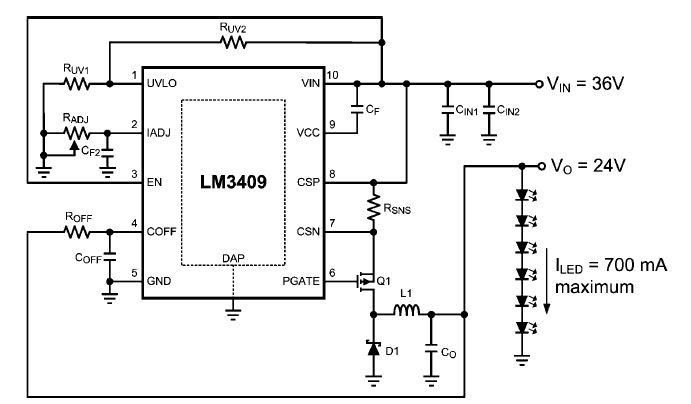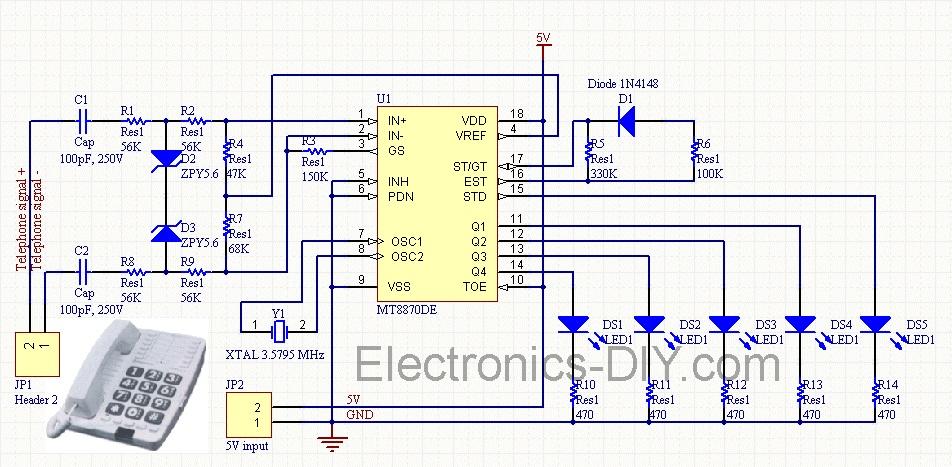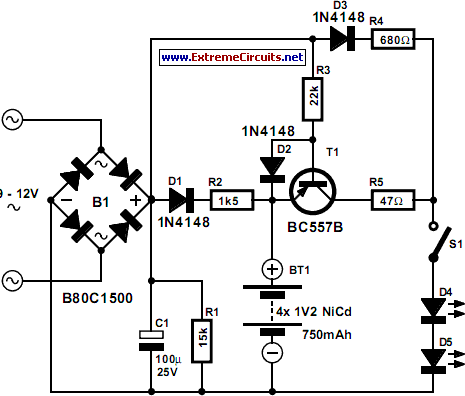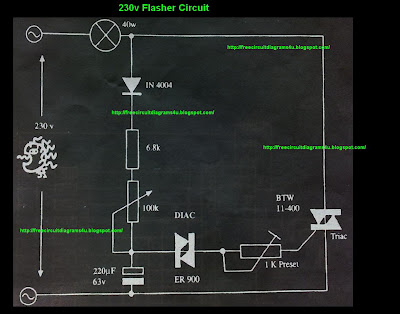
Constant Current Source LED Drive
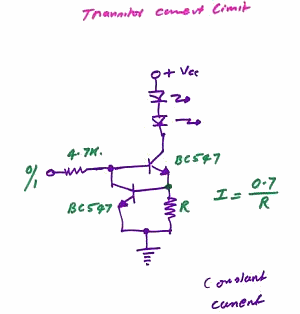
This is a constant current source LED driver. When the upper NPN transistor is activated by a voltage through a 4.7kΩ resistor, the LED lights up. It is assumed that the lower NPN transistor is absent. The current flowing through the LED and NPN is limited by a resistor. A current of 20mA may be acceptable, while 15mA is preferred to prevent damage to the LED and transistor. The BC547 transistor has a maximum collector current rating of 100mA, a voltage rating of 40V, and a current gain of 200. It is recommended to operate at less than 25V, which can provide a DC current amplification of up to 200 times. This means that a base-emitter current of 1µA could yield a collector-emitter current of 200µA. In the absence of the lower NPN, the resistor value can be calculated using the formula: Vcc (2 LEDs * 1.7V) - Vce = Vr, where Vce is the voltage drop across the resistor. According to Ohm's law, the desired current for a bright and long-lasting LED is 15mA. The forward voltage drop of a green LED is approximately 1.7V, while a saturated or turned-on NPN has a Vce of around 0.6V. Introducing the lower NPN alters these calculations. If a small current flows through the LED, the voltage across the resistor will be less than 0.7V, preventing the base-emitter diode of the lower NPN from conducting. Consequently, the collector does not draw any current. As the current through the LED increases, the voltage across the resistor exceeds 0.7V, biasing the lower NPN. This allows the collector of the lower NPN to draw current from the base of the upper NPN, which reduces its bias and subsequently lowers the LED current, effectively regulating it.
The constant current source LED driver circuit is designed to provide a stable current to an LED, ensuring its longevity and performance. The circuit primarily consists of two NPN transistors, resistors, and the LED itself. The upper NPN transistor acts as the main switch for the LED, while the lower NPN transistor serves as a feedback mechanism to regulate the current flowing through the LED.
The circuit operates as follows: when a voltage is applied through the 4.7kΩ resistor to the base of the upper NPN transistor, it turns on, allowing current to flow through the LED. The LED's forward voltage drop is typically around 1.7V for a green LED, and this voltage is taken into account when determining the resistor value. The current flowing through the LED is limited by the resistor, ensuring that it does not exceed the safe operating limits of the LED and the transistors.
In the absence of the lower NPN transistor, the upper NPN transistor would operate independently, and the current could potentially exceed the desired level, leading to damage. However, with the lower NPN in place, it monitors the current through the LED. As the LED current increases, the voltage across the resistor rises, eventually reaching the threshold voltage of 0.7V required to turn on the lower NPN transistor. Once activated, the lower NPN begins to draw current from the base of the upper NPN, reducing its bias and consequently lowering the LED current. This feedback mechanism ensures that the current remains within the desired range, providing a stable and reliable operation of the LED driver circuit.
The choice of transistors, such as the BC547, is critical for the performance of the circuit, as it must handle the expected current and voltage levels. The circuit should also be tested under various conditions to ensure that it operates effectively across the intended range of input voltages and load conditions. Proper thermal management and component selection are essential to prevent overheating and ensure long-term reliability of the LED driver.This is a Constant Current Source LED Driver, When the LED driver Upper-NPN is driven by a voltage thru 4. 7K the LED lights up. Assume that the Lower-NPN at bottom is absent. The current via LED and NPN is limited by R. 20mA may be ok 15mA even better. Or LED blows even transistor goes. BC547 is like 100mA-40V-200b, Limit collector current to 60mA , use it at less than 25V and depending on the individual transistor you may get a DC current amplification of 200 times. That is 1uA of base-emitter current could give a whooping 200uA of collector-emitter current. Still Thinking we do not have the Lower-NPN we calculate the resistor. Vcc ( 2 LEDs * 1. 7) Vce = Vr that is the voltage across the resistor. You know ohms law and the current needs to be 15mA for a bright and long lasting LED. Lastly 1. 7 the forward drop of a green LED and 0. 6 a saturated or Turrned-On NPN Vce. Now you use the Lower-NPN, The above calculations do not hold anymore. Let us think a small current is flowing in the LED. Then the voltage across R is less than 0. 7V, that means base-emitter diode of the Lower-NPN will not get to conduct. The Collector does not draw any current away. Now think that more current flows in LED, the voltage across R builds up above 0. 7V the Lower-NPN is biased. The collector of Lower-NPN starts drinking current from the base of the Upper-NPN. So The Upper-NPN starts losing its bias. This lowers the LED current and contains, regulates or controls the LED current as shown in the formula.
We aim to transmit more information by carrying articles. Please send us an E-mail to wanghuali@hqew. net within 15 days if we are involved in the problems of article content, copyright or other problems. We will delete it soon. 🔗 External reference
The constant current source LED driver circuit is designed to provide a stable current to an LED, ensuring its longevity and performance. The circuit primarily consists of two NPN transistors, resistors, and the LED itself. The upper NPN transistor acts as the main switch for the LED, while the lower NPN transistor serves as a feedback mechanism to regulate the current flowing through the LED.
The circuit operates as follows: when a voltage is applied through the 4.7kΩ resistor to the base of the upper NPN transistor, it turns on, allowing current to flow through the LED. The LED's forward voltage drop is typically around 1.7V for a green LED, and this voltage is taken into account when determining the resistor value. The current flowing through the LED is limited by the resistor, ensuring that it does not exceed the safe operating limits of the LED and the transistors.
In the absence of the lower NPN transistor, the upper NPN transistor would operate independently, and the current could potentially exceed the desired level, leading to damage. However, with the lower NPN in place, it monitors the current through the LED. As the LED current increases, the voltage across the resistor rises, eventually reaching the threshold voltage of 0.7V required to turn on the lower NPN transistor. Once activated, the lower NPN begins to draw current from the base of the upper NPN, reducing its bias and consequently lowering the LED current. This feedback mechanism ensures that the current remains within the desired range, providing a stable and reliable operation of the LED driver circuit.
The choice of transistors, such as the BC547, is critical for the performance of the circuit, as it must handle the expected current and voltage levels. The circuit should also be tested under various conditions to ensure that it operates effectively across the intended range of input voltages and load conditions. Proper thermal management and component selection are essential to prevent overheating and ensure long-term reliability of the LED driver.This is a Constant Current Source LED Driver, When the LED driver Upper-NPN is driven by a voltage thru 4. 7K the LED lights up. Assume that the Lower-NPN at bottom is absent. The current via LED and NPN is limited by R. 20mA may be ok 15mA even better. Or LED blows even transistor goes. BC547 is like 100mA-40V-200b, Limit collector current to 60mA , use it at less than 25V and depending on the individual transistor you may get a DC current amplification of 200 times. That is 1uA of base-emitter current could give a whooping 200uA of collector-emitter current. Still Thinking we do not have the Lower-NPN we calculate the resistor. Vcc ( 2 LEDs * 1. 7) Vce = Vr that is the voltage across the resistor. You know ohms law and the current needs to be 15mA for a bright and long lasting LED. Lastly 1. 7 the forward drop of a green LED and 0. 6 a saturated or Turrned-On NPN Vce. Now you use the Lower-NPN, The above calculations do not hold anymore. Let us think a small current is flowing in the LED. Then the voltage across R is less than 0. 7V, that means base-emitter diode of the Lower-NPN will not get to conduct. The Collector does not draw any current away. Now think that more current flows in LED, the voltage across R builds up above 0. 7V the Lower-NPN is biased. The collector of Lower-NPN starts drinking current from the base of the Upper-NPN. So The Upper-NPN starts losing its bias. This lowers the LED current and contains, regulates or controls the LED current as shown in the formula.
We aim to transmit more information by carrying articles. Please send us an E-mail to wanghuali@hqew. net within 15 days if we are involved in the problems of article content, copyright or other problems. We will delete it soon. 🔗 External reference


